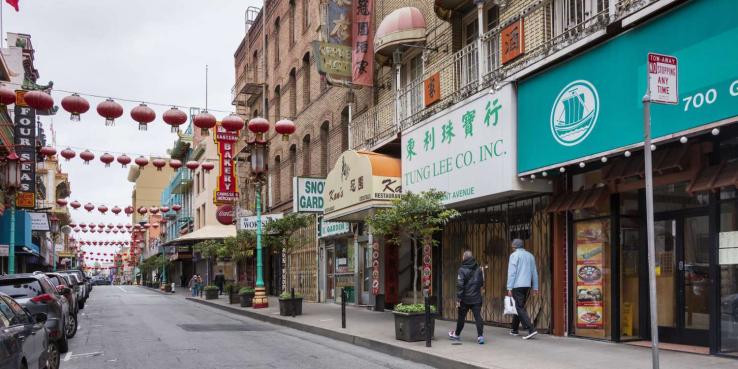Since the advent of e-commerce and other recent changes in the economy, the future of ground floor retail has looked uncertain. With COVID-19, their condition has become critical. The actions cities and counties have taken to reduce virus transmission have put ground floor businesses, and the public life they support, at great risk.
SPUR recently released Keeping the Doors Open, a Rising Together policy brief proposing 10 actions cities can take to support the survival of ground floor businesses. Over the years, we have returned frequently to the key role that the ground floor plays in people’s day-to-day lives as they work, shop, commute, eat and gather. We have written about how to make it viable to build housing above retail, how to design a great ground floor and why the zoning code matters for urban design. Today it is clearer than ever that ground floor spaces are critical to the local economy, housing small businesses, jobs and entrepreneurs in our neighborhoods and commercial areas.
As cities consider what steps to take to re-open and preserve small businesses, we recommend keeping three principles in mind:
Move quickly and remain flexible.
Cities should waive or suspend regulations not needed for health and safety. They can also dial back enforcement, focus on education and adjust the approach to the needs of specific neighborhoods.
Focus on neighborhoods.
Neighborhood-serving storefronts are particularly in need of assistance. Ensuring the continued operation of businesses owned and operated by people of color, in particular, is not just an economic benefit but also a safeguard on sense of place and belonging. In places where the infrastructure exists, leverage the capacity of merchant associations, business improvement districts and community benefit districts. In places where these types of organizations are less well-resourced or non-existent, the city must step up to provide supplementary support and resources.
Center racial and social equity in directing resources.
Provide additional supports (financial, language, technical assistance) to businesses serving low- and moderate-income households and people of color. These businesses were likely already more fragile to begin with, and the pandemic has served to only exacerbate existing inequities.
We worked with partners across the region to develop short-term recommendations for cities as they take immediate steps to keep existing businesses alive. Our partners included owners and operators of small businesses, architects and designers, planners, city staff from around the Bay Area, retail brokers, public space experts, nonprofit organizations and representatives of community benefit districts and merchant associations. Recommendations include cities taking a bigger role in distributing PPE (personal protective equipment), allowing restaurants and retail to more easily occupy streets and sidewalks, and incentivizing the completion of seismic renovations while storefronts are not occupied.
Here are three specific ideas that we think deserve a hard look:
- Permit-less registration of COVID-19-required alterations. Changes to enable physical distancing — like walk-up/takeout windows, awnings, signage, and changes to kitchen and counter configurations — would not require an approval process. Cities should implement a no-cost, same-day process for project sponsors to register a limited set of improvements to existing facilities for the purposes of safety and business survival. Full permit approval of any permanent improvements should be deferred to a future date.
- Relaxed planning and zoning requirements. This would give existing businesses implicit approval on a temporary basis to operate with greater flexibility without requiring a change-of-use permit. For example, cities could allow restaurants to also sell produce and grocery items (something that’s already happening on an ad hoc basis) or allow restaurant and retail spaces to increase the amount of space dedicated to production or light manufacturing without a permitting process.
- “One-stop” stations for permitting and resources. These could operate in neighborhoods across the region (not just at city halls) and could be staffed with multilingual representatives from regulatory agencies (planning, building, public works, transportation, fire, economic development) to help streamline the approval of urgent permits and the acceptance of proposed permit-less scopes of work. Designers and consultants could also offer pro-bono advice at these stations.
As cities reopen, they will need to maintain flexibility and relax some existing standards and practices in order to allow storefront businesses to adapt to changing guidelines, norms and comfort levels. The Bay Area’s neighborhoods will thrive again, but interventions will be needed to preserve the neighborhood-serving businesses and the jobs, community identity, public gathering space and sense of belonging they provide. In addition to the short-term recommendations we have released, SPUR will also be looking at intermediate and longer-term interventions to help ground floor businesses and commercial districts return and thrive.
